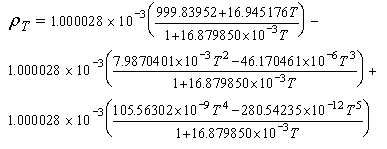Difference between revisions of "Calculating the Density Temperature Correction"
Bill Bashir (talk | contribs) |
Bill Bashir (talk | contribs) |
||
| (One intermediate revision by the same user not shown) | |||
| Line 1: | Line 1: | ||
| + | [[Category:Sednterp]][[Category:Theory of Computer Aided Interpretation of Sedimentation Data]] | ||
The first step Sednterp uses to calculate the density of a buffer is to calculate the density of the buffer at 20 degrees C. Then, the density is corrected for temperature assuming that water and the isotopes of water are the predominant components in the buffer. While this is true for solutions containing moderate amounts of other components, significant errors may be introduced for solutions containing high solute concentrations. | The first step Sednterp uses to calculate the density of a buffer is to calculate the density of the buffer at 20 degrees C. Then, the density is corrected for temperature assuming that water and the isotopes of water are the predominant components in the buffer. While this is true for solutions containing moderate amounts of other components, significant errors may be introduced for solutions containing high solute concentrations. | ||
Latest revision as of 16:32, 23 December 2011
The first step Sednterp uses to calculate the density of a buffer is to calculate the density of the buffer at 20 degrees C. Then, the density is corrected for temperature assuming that water and the isotopes of water are the predominant components in the buffer. While this is true for solutions containing moderate amounts of other components, significant errors may be introduced for solutions containing high solute concentrations.
For pure water, equation 14 from the CRC Handbook of Chemistry and Physics (Ref. 44) is used.
Equation 14.
where T is the temperature in degrees C and the multiplicative factor converts the units from kg/m^3 to g/ml. Densities calculated with equation 14 are good to at least 5 decimal places over the 0-100 C range.
For the isotopes of water, equation 12 derived from the methods described by Steckel and Szapiro(Ref. 45): is used as the temperature correction.
Equation 12.
where ρT is the density at temperature T in C, ρmax is the maximum density (observed at the maximum temperature), is the temperature difference between that of the experiment and the temperature of maximum density, and F is an empirical constant. Equation 12 may be used for all water species by substituting in the appropriate values from the following table. Note that in cases where O-18 is present, isotopic purity is about 98%, and it is 100% when D is present. Values for H2O reflect the natural isotopic abundance of O-18 and D. Likewise, O and H reflect natural isotopic abundance in D2O and H2O18. Equation 12 is valid from the melting temperature to approximately 80 C. Simple mixing rules are used when different isotopes of water are combined. (Ref. 45) The values used in equation 12 are loaded in the phyconst database and are listed here also:
The final correction for temperature is performed by multiplying the density of the buffer at 20 C by the ratio of the water component(s) densities at the experimental temperature and 20 C.
Equation 15.



